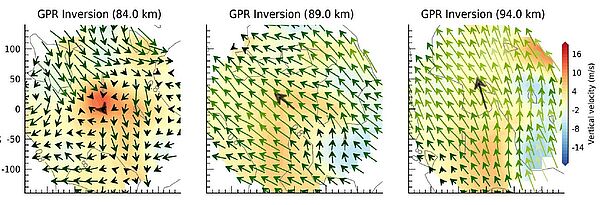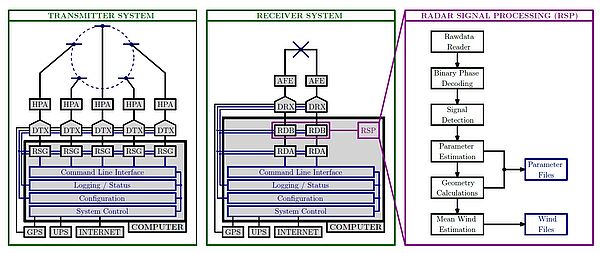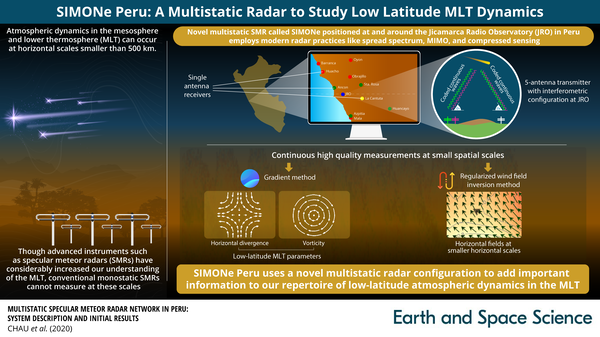SIMONe systems
Specular meteor radars (SMRs) are reliable and powerful tools to investigate mesosphere and lower thermosphere (MLT) dynamics. Reliable, because they operate 24/7 under any sort of weather conditions. Powerful, because they can provide accurate horizontal winds with a reasonable time resolution (~ 1 hour) for altitudes between 80 and 100 km. Ideally, one would like to know the wind vector at any point in space and time, i.e., to determine the wind fields. However, in order to do the latter, the geometry of conventional SMR observations has to be modified and upgraded to a multistatic configuration.
With this idea in mind, the IAP has recently developed the MMARIA (Multistatic Multi-frequency Agile Radar for Investigations of the Atmosphere) concept. MMARIA represents an extension of traditional meteor radar systems in which several spatially separated receivers are added to existing transmitting stations, and/or several spatially separated transmitters are added to existing interferometric receiving stations (Stober and Chau, 2015, Chau et al., 2017). Besides detecting between half and one order of magnitude more meteors, the MMARIA systems are able to observe almost the same detection volume from different viewing angles, which is essential to determine the horizontal wind fields (see figure 1).
The MMARIA concept can be materialized with both pulsed and coded continuous wave (CW) meteor radar systems. The latter approach is named SIMONe (Spread spectrum Interferometric multistatic Meteor radar Observing Network), and it has been proven to provide MLT winds with unprecedented time resolution (Vierinen et al., 2019), and to be significantly more cost-effective and easier to install than conventional SMRs. Furthermore, unlike other instrumentation (e.g., optical measurements, lidars), SMR networks like SIMONe are perfectly suited for continuous, long-term records.
SIMONe systems have been developed by IAP, in collaboration with MIT Haystack (US) and the Arctic University of Norway (Chau et al., 2019). A description of the operational SIMONe systems can be found in Chau et al., (2021). Thanks to the large amount of meteors that these systems can detect (see figure 2 for examples of daily meteor counts), novel approaches such as the wind field correlation function inversion (WCFI) technique (Vierinen et al., 2019) can be implemented to, for example, obtain horizontal correlations of the vertical vorticity and horizontal divergence. Recently, the latter two parameters have been investigated for the first time at MLT altitudes using SIMONe observations (e.g., Poblet et al., 2022). Studies like this are crucial, since they can shed light on the type of physical mechanism driving the MLT dynamics at horizontal scales of approximately 50 to 450 km, i.e., mesoscales.
Currently, the IAP operates five different multistatic SMR networks. Two in Europe, MMARIA Norway (69°N) and MMARIA Germany (53°N), and three in South America, SIMONe Piura (5°S) and SIMONe Jicamarca (12°S), in Peru, and SIMONe Argentina (49°S), in southern Patagonia.




Figure 2. 2D histograms of the meteor counts for one day of observations at four of the five multistatic SMR networks operated by IAP
In Argentina, the first SIMONe system was installed in 2019, in the province of Santa Cruz. The five-antenna transmitter located in the municipality of Tres Lagos consists of the SanDRA system developed at IAP, which, in combination with commercial amplifier technologies, transmits coded CW signals. The signals scattered by the meteor trails are registered at five different locations at a distance of up to 250 km (Conte et al., 2021). To determine the position of the specular points, the coded information of the five transmitters is coherently combined at each receiving site. The further determination of the horizontal winds can be done individually for each receiving location or also combined for the wind fields. Similar SIMONe systems, comprising a five-antenna transmitter and five separate single-antenna receiving stations, were installed around Jicamarca in 2019 and around Piura in 2021.
Current SIMONe networks
| Country, region | Network center | Transmitter sites x channel | Receiver sites x channel | Frequency / MHz |
| Germany | 53.0°N, 12.5°E | 2x 6 | 5x 2 + 2x 10 | 32.55 |
| Norway | 68.9°N, 17.1°E | 1x 6 | 3x 2 + 1x 10 | 32.55 |
| Argentina | 49.6°S, 71.5°W | 1x 5 | 5x 2 | 32.55 |
| Peru, Jicamarca | 11.7°S, 76.8°W | 1x 6 | 5x 2 | 32.55 |
| Peru, Piura | 5.5°S, 80.4°W | 1x 6 | 5x 2 | 32.55 |
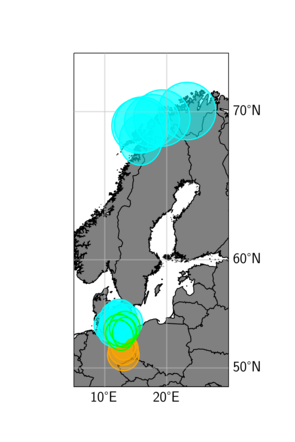
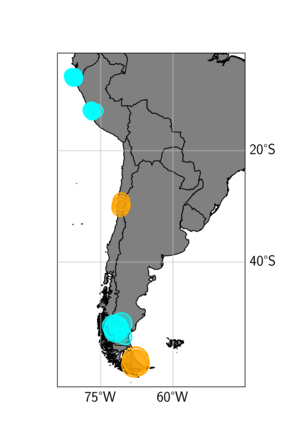
Related publications
Chau, J. L., G. Stober, C. M. Hall, M. Tsutsumi, F. I. Laskar und P. Hoffmann (2017). Polar mesospheric horizontal divergence and relative vorticity measurements using multiple specular meteor radars, Radio Sci., 52, 811-828, doi:10.1002/2016RS006225.
Chau, J. L., J. M. Urco, J. P. Vierinen, R. A. Volz, M. Clahsen, N. Pfeffer und J. Trautner (2019). Novel specular meteor radar systems using coherent MIMO techniques to study the mesosphere and lower thermosphere, Atmos. Meas. Tech., 12, 2113-2127, doi:10.5194/amt-12-2113-2019.
Conte, J. F., Chau, J. L., Urco, J. M., Latteck, R., Vierinen, J., and Salvador, J. O. (2021). First studies of mesosphere and lower thermosphere dynamics using a multistatic specular meteor radar network over southern Patagonia. Earth and Space Science, 8, doi.org/10.1029/2020EA001356.
Poblet, F., J. L. Chau, J. F. Conte, V. Avsarkisov, J. Vierinen, and H. Charuvil Asokan (2022). Horizontal wavenumber spectra of vertical vorticity and horizontal divergence in the mesosphere and lower thermosphere using multistatic specular meteor radar observations, Earth and Space Science,9, doi.org/10.1029/2021EA002201
Stober, G. and J. L. Chau (2015). A multistatic and multifrequency novel approach for specular meteor radars to improve wind measurements in the MLT region, Radio Sci., 431-442, doi:10.1002/2014RS005591.
Vierinen, J., Chau, J. L., Charuvil, H., Urco, J. M., Clahsen, M., Avsarkisov, V., Marino, R., and Volz, R. (2019). Observing mesospheric turbulence with specular meteor radars: A novel method for estimating second-order statistics of wind velocity. Earth and Space Science, 6. doi.org/10.1029/2019EA000570.
Volz, R., Chau, J. L., Erickson, P. J., Vierinen, J. P., Urco, J. M., and Clahsen, M. (2021). Four-dimensional mesospheric and lower thermospheric wind fields using Gaussian process regression on multistatic specular meteor radar observations, Atmos. Meas. Tech., 14, 7199–7219, doi.org/10.5194/amt-14-7199-2021.












